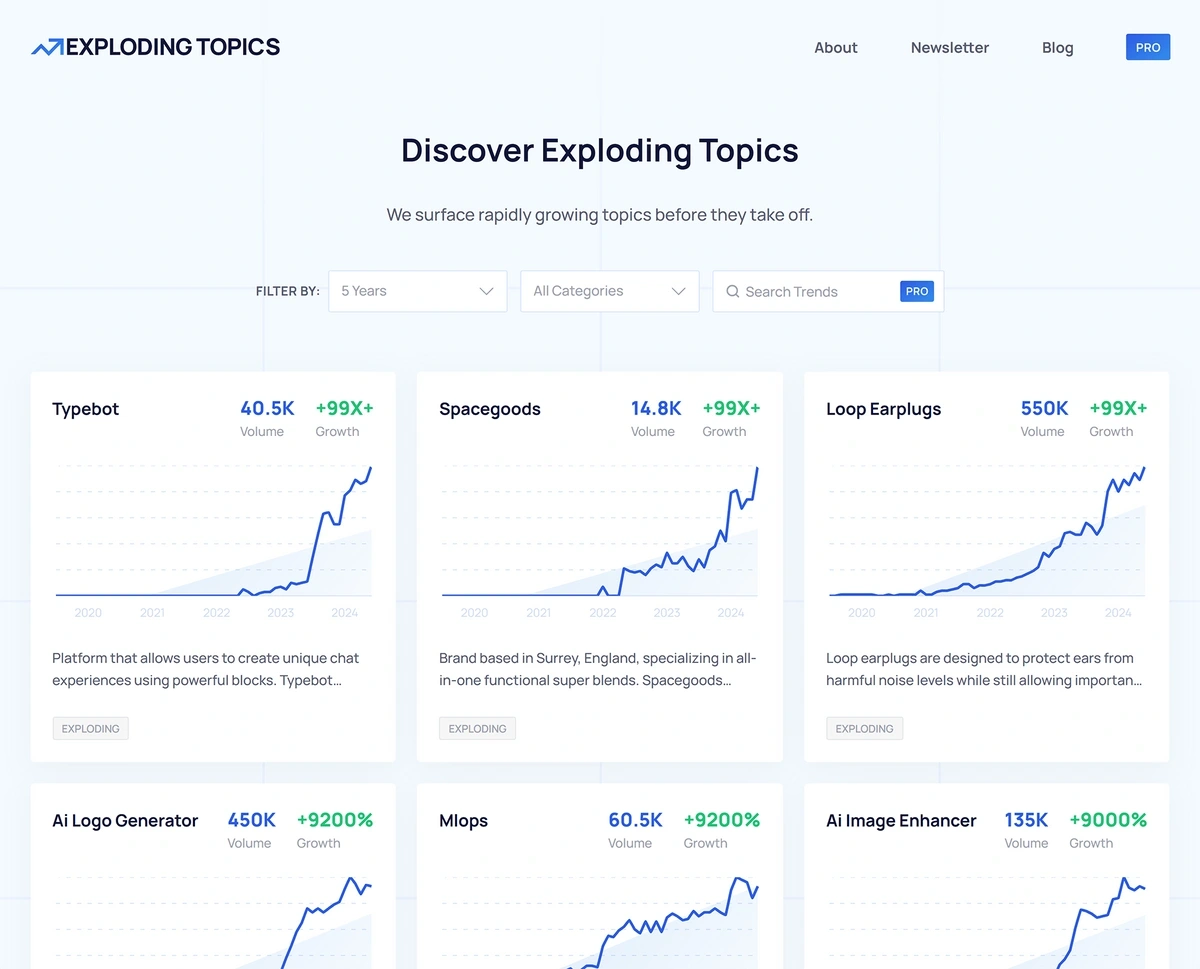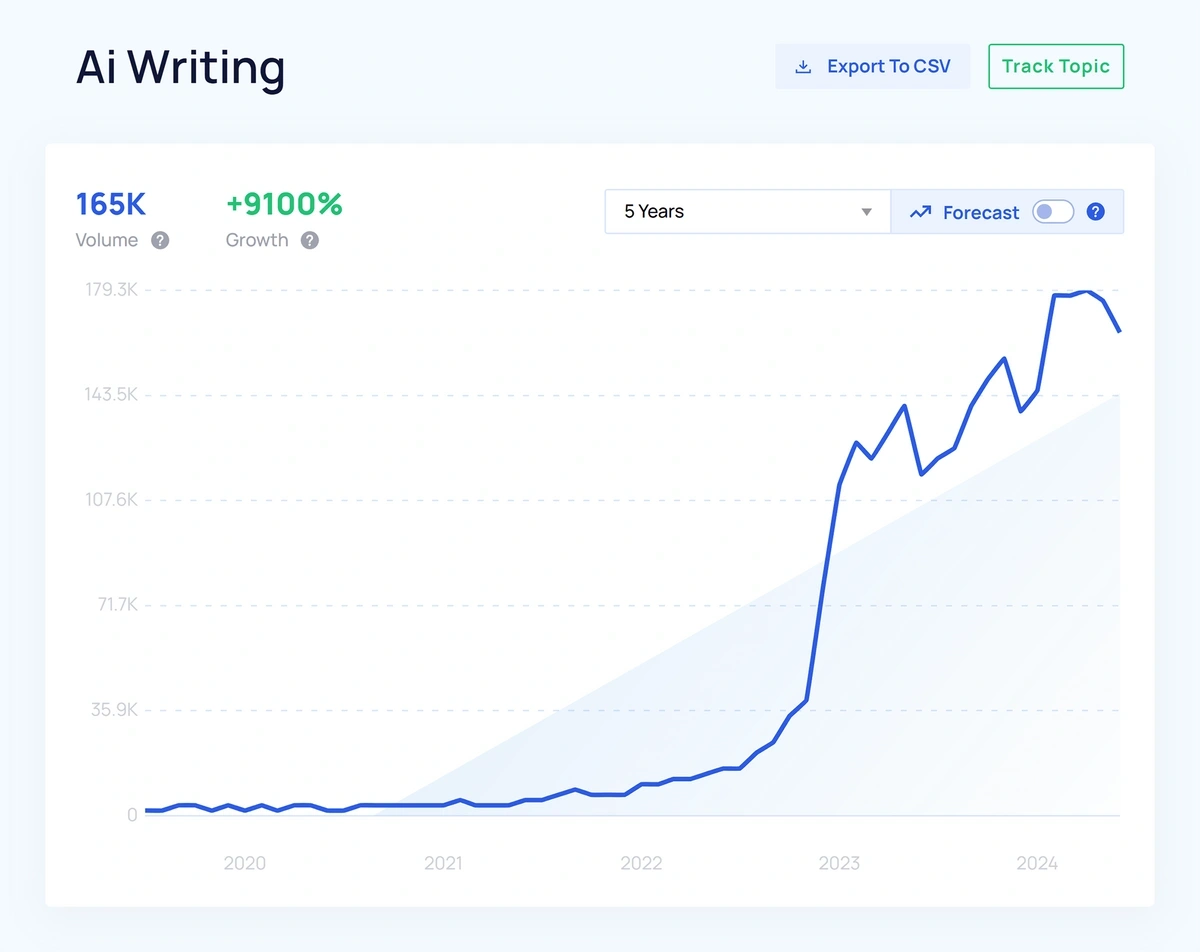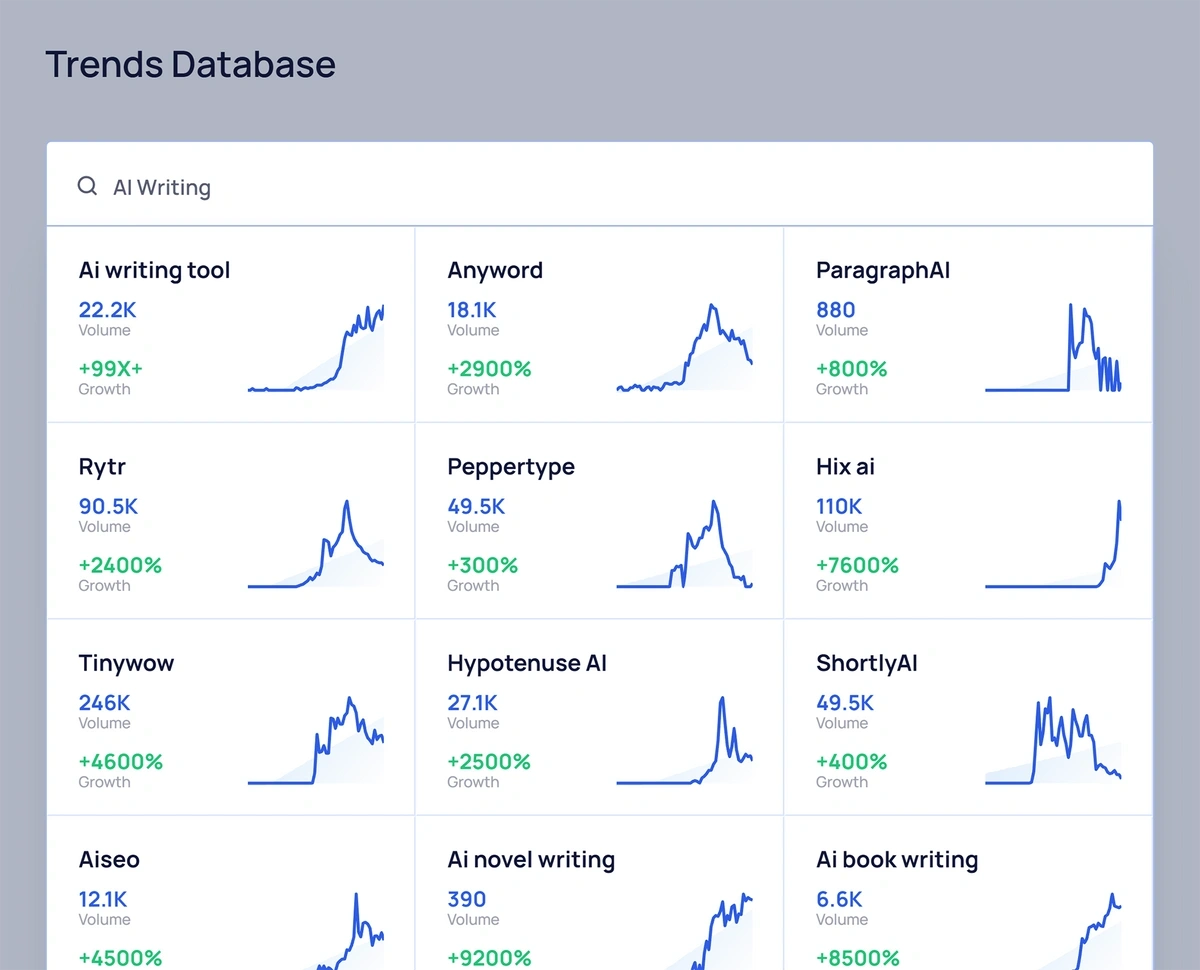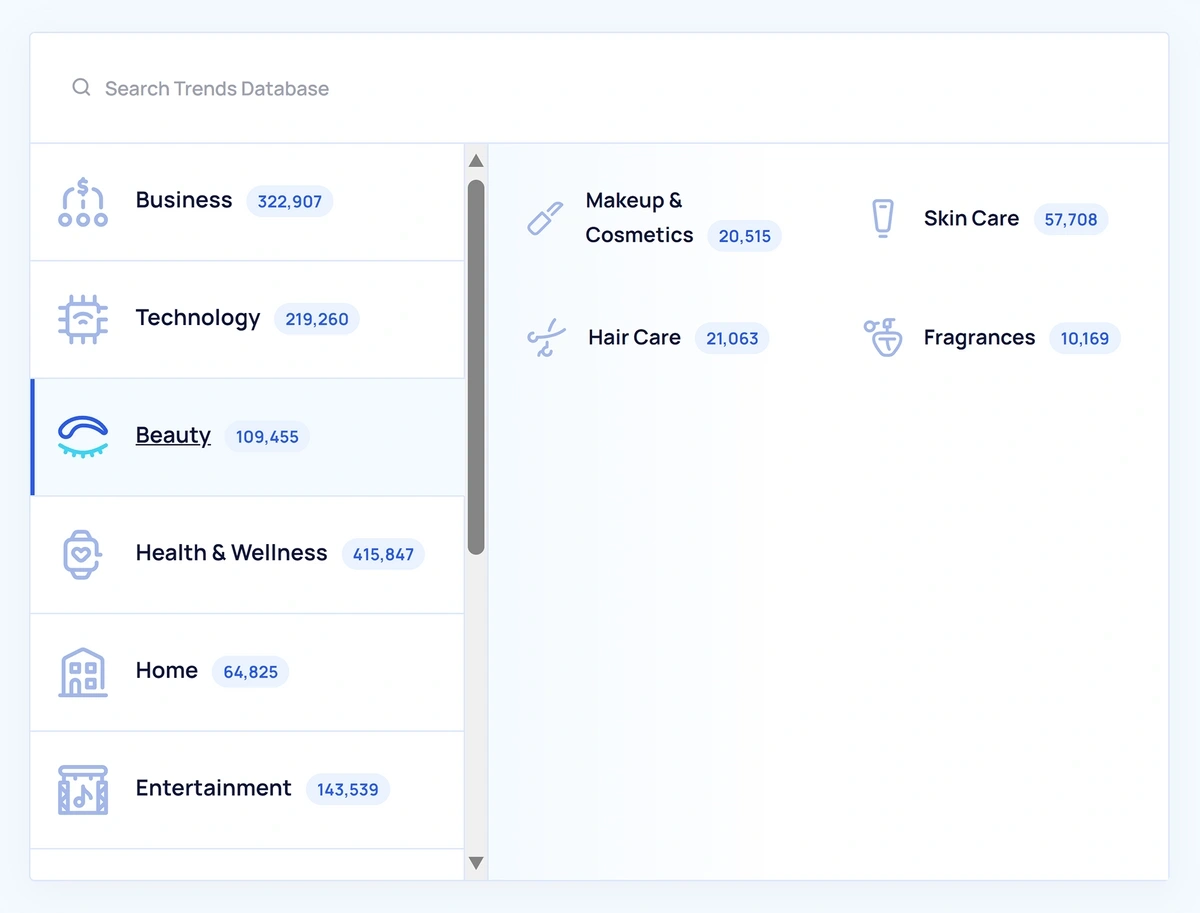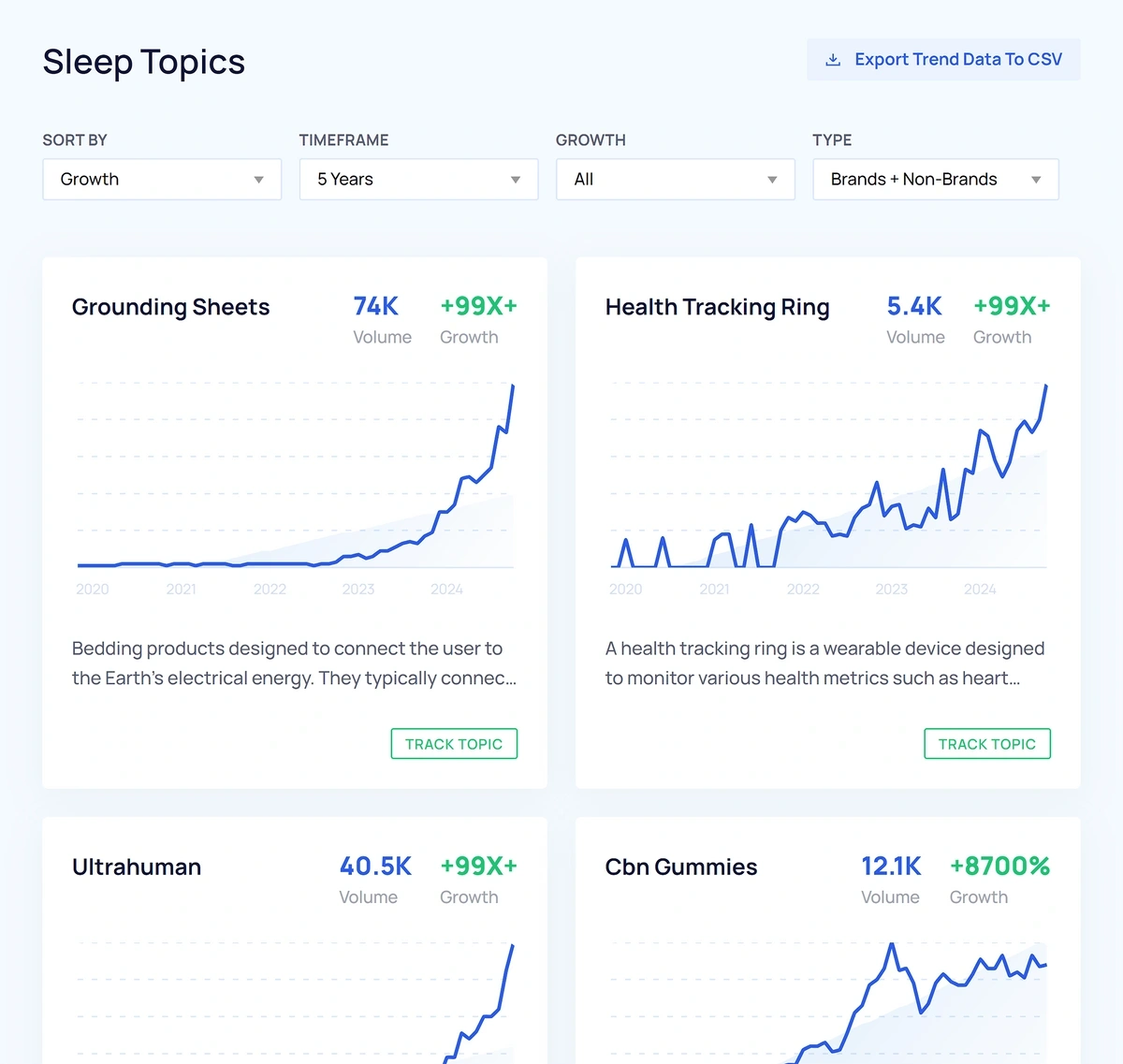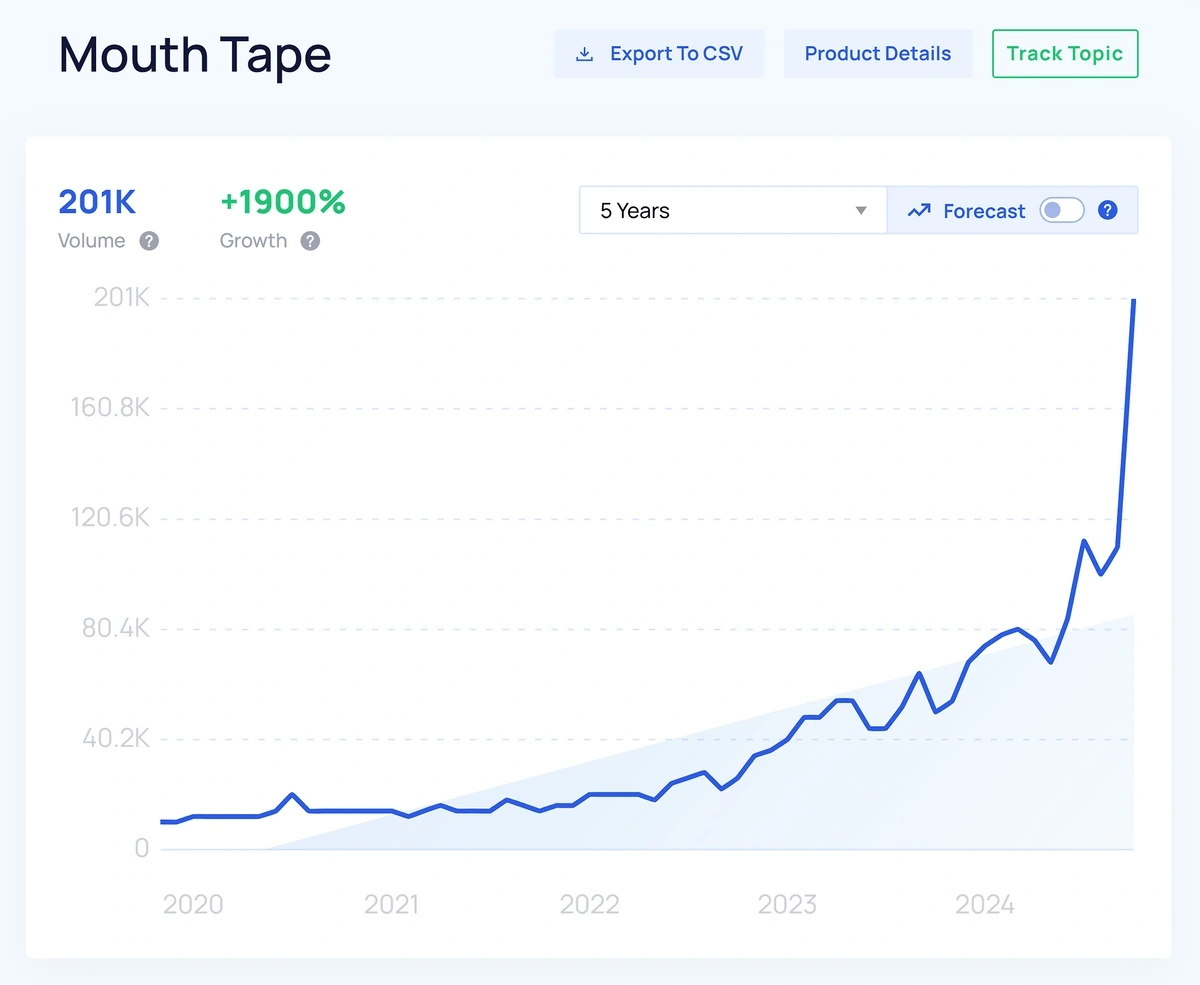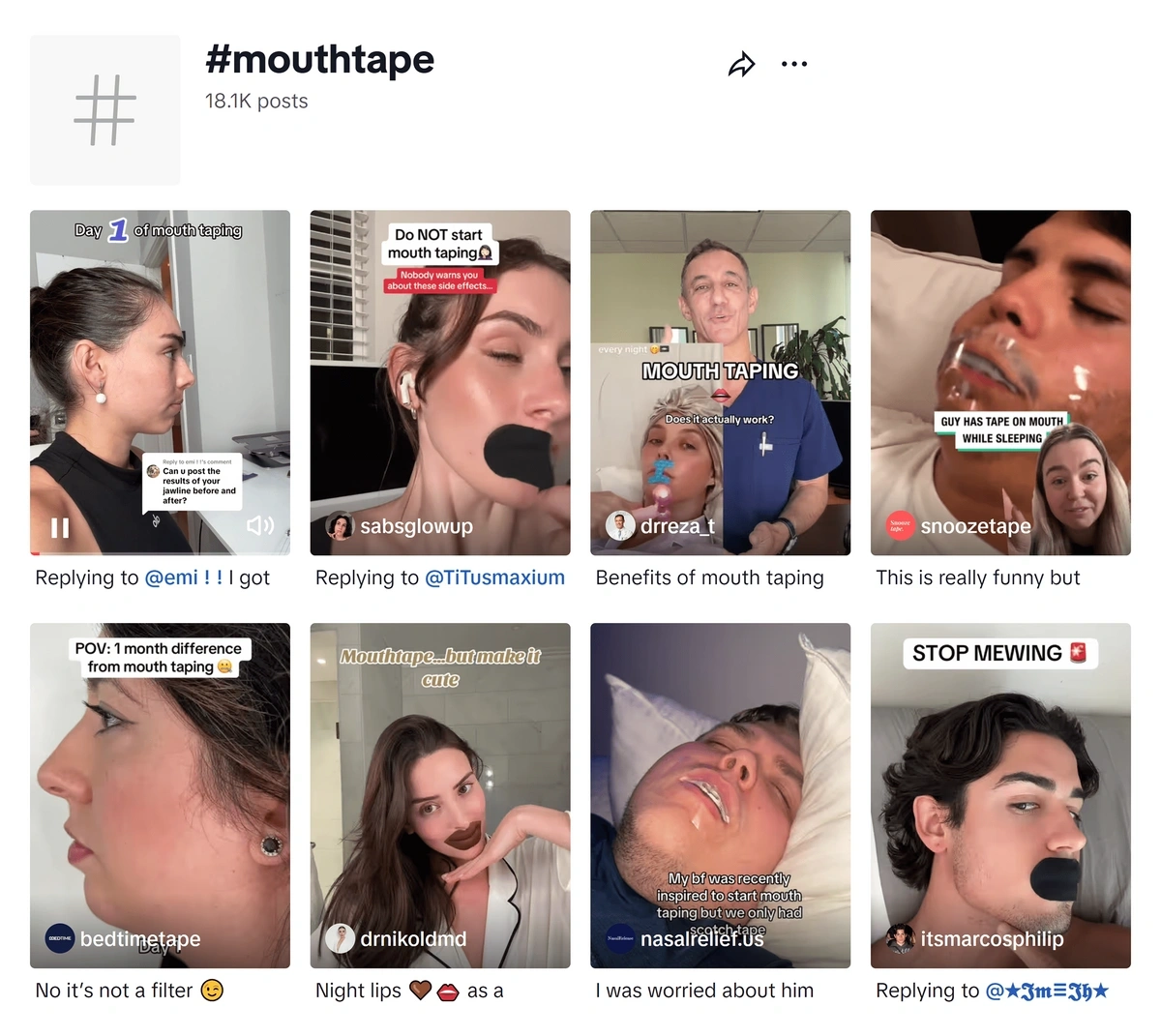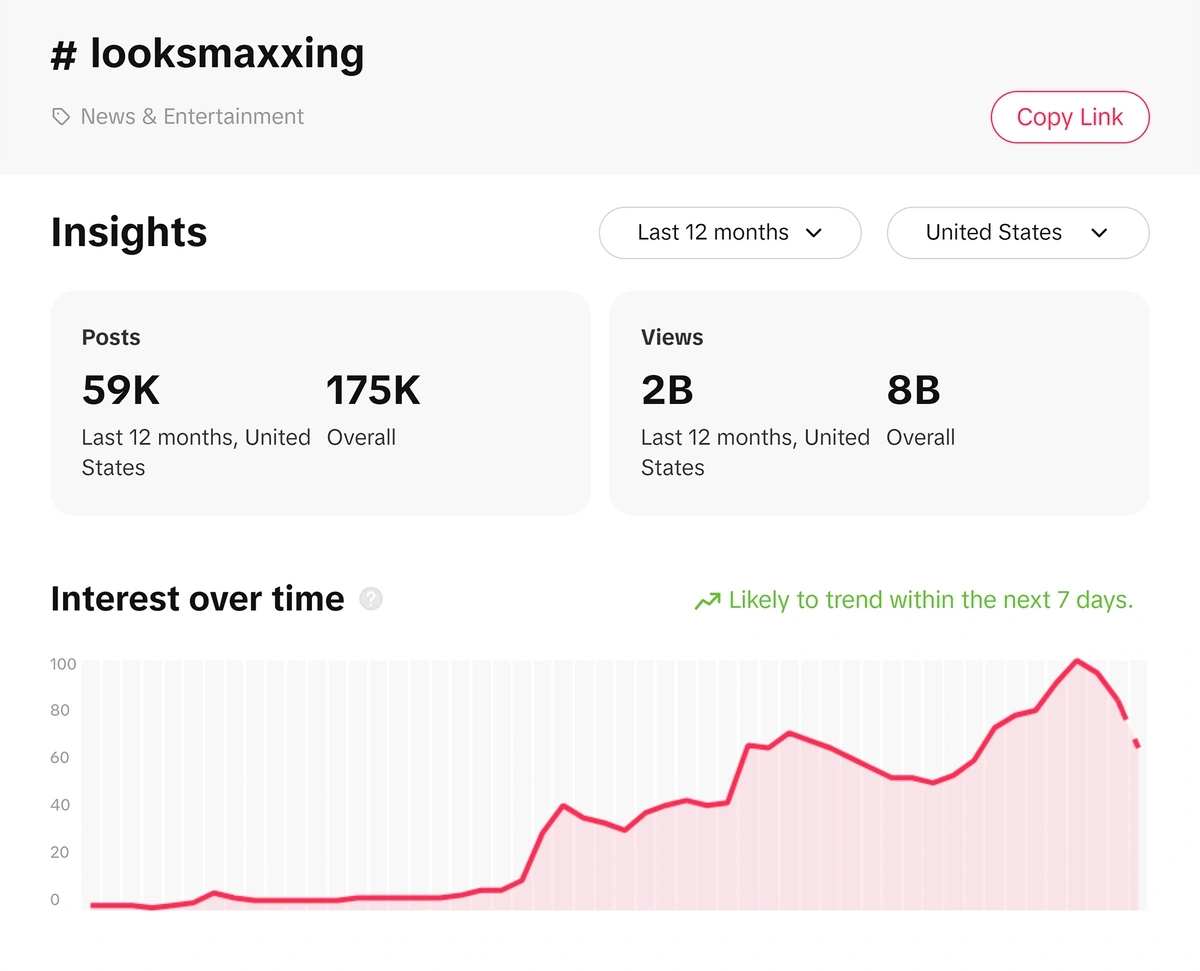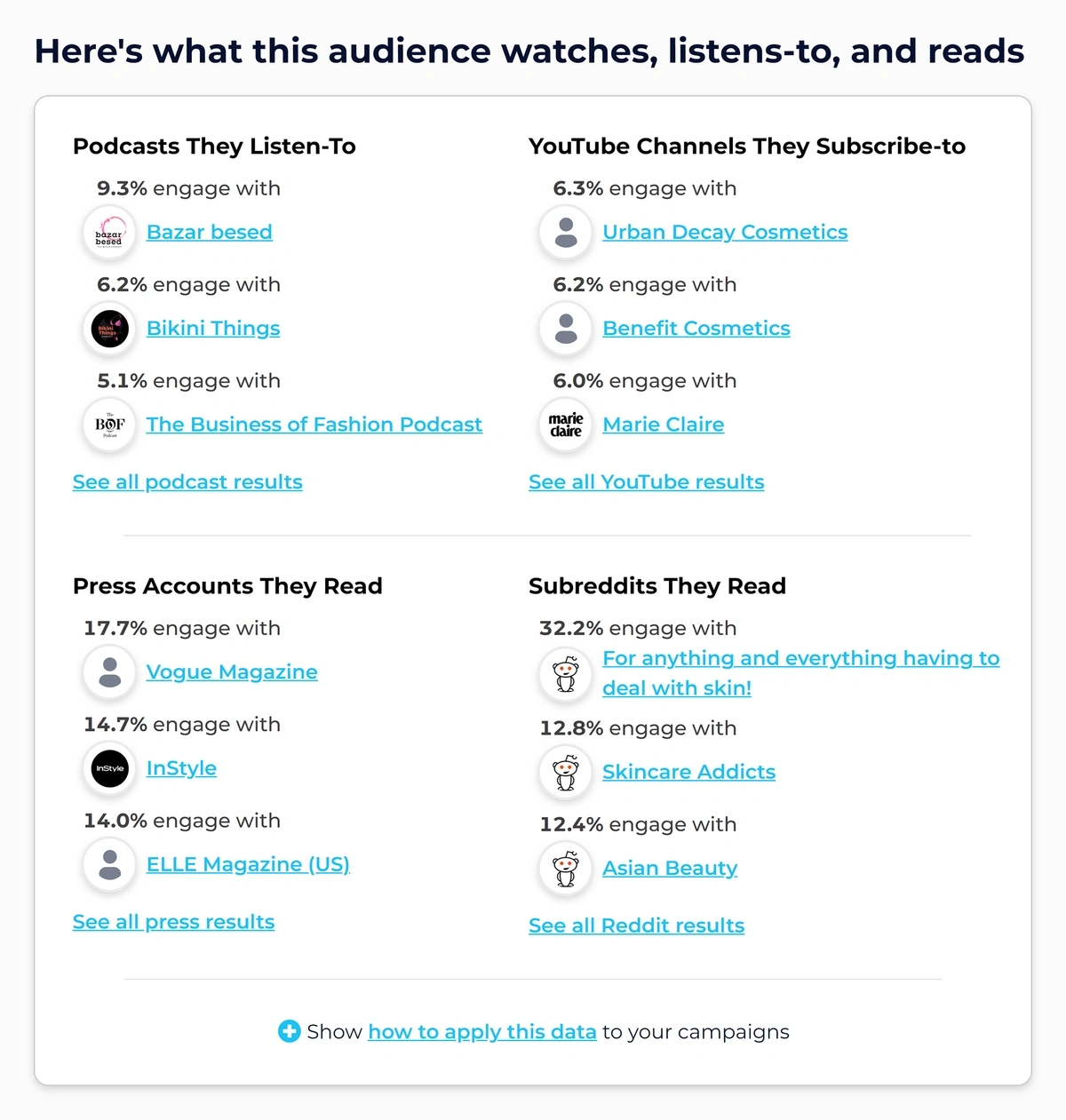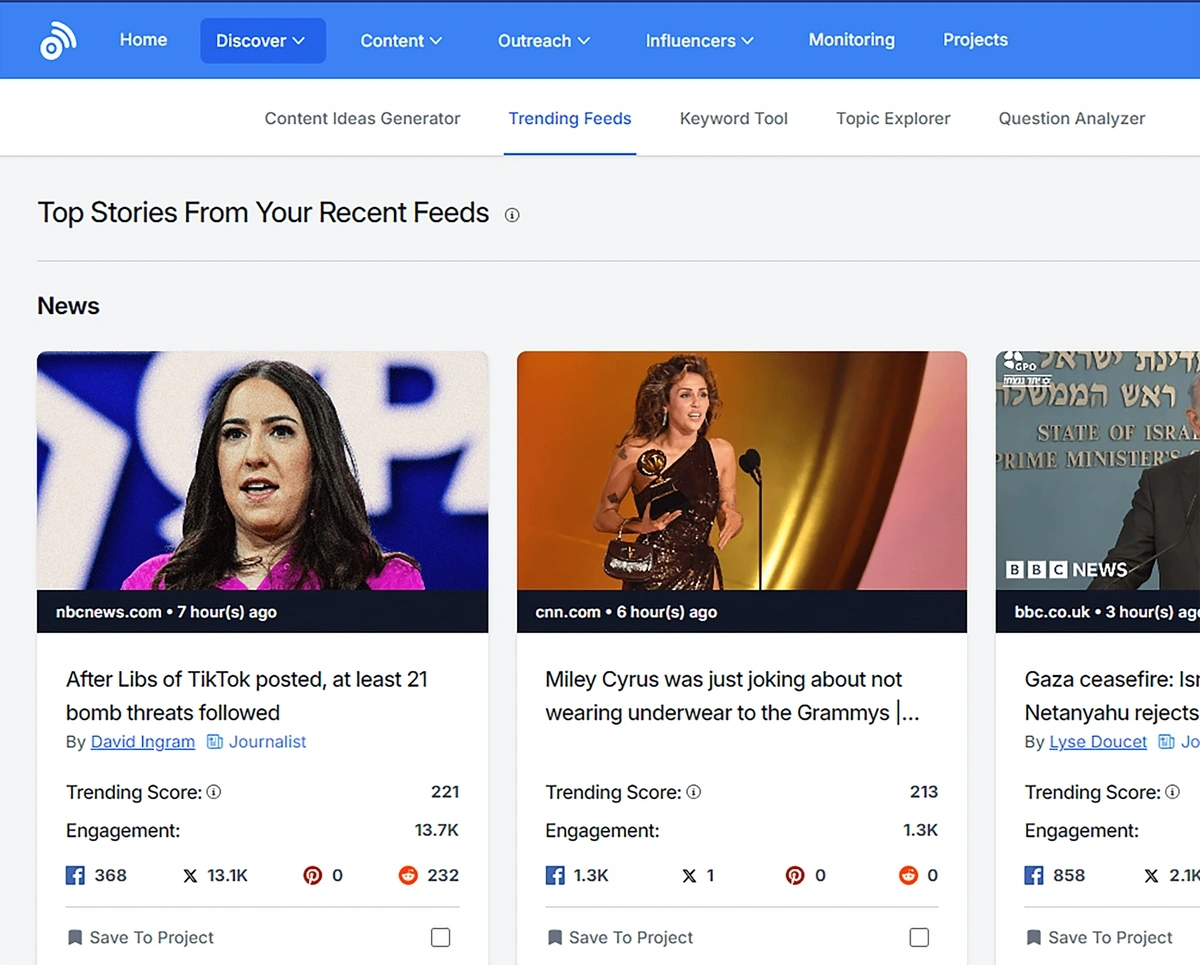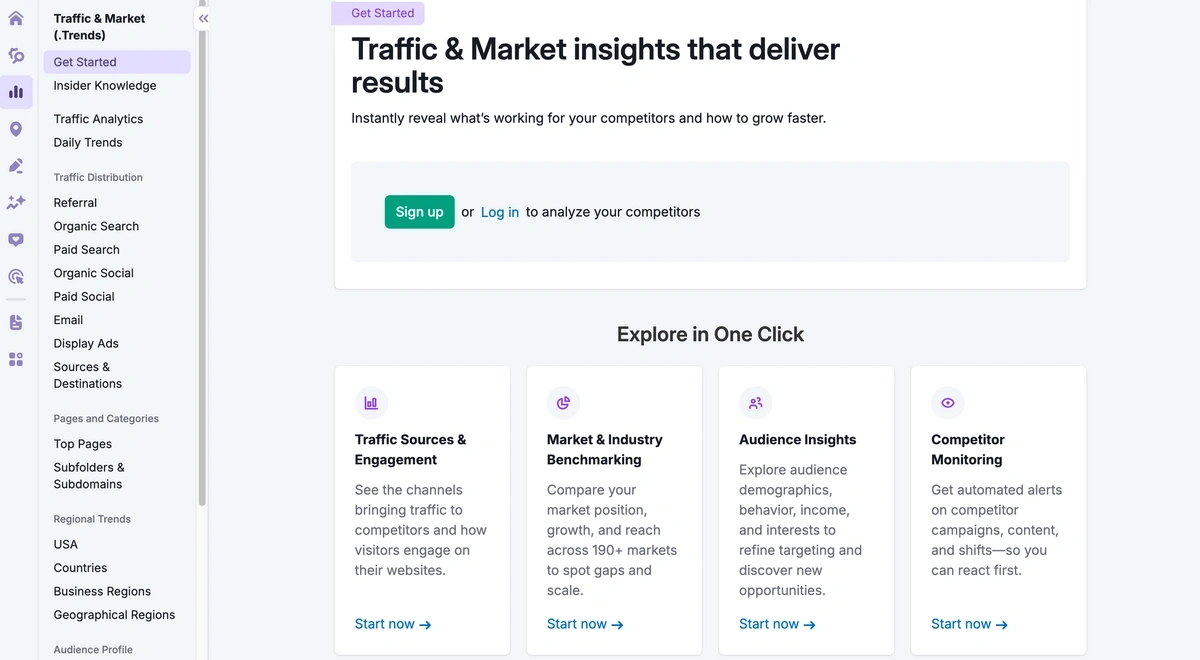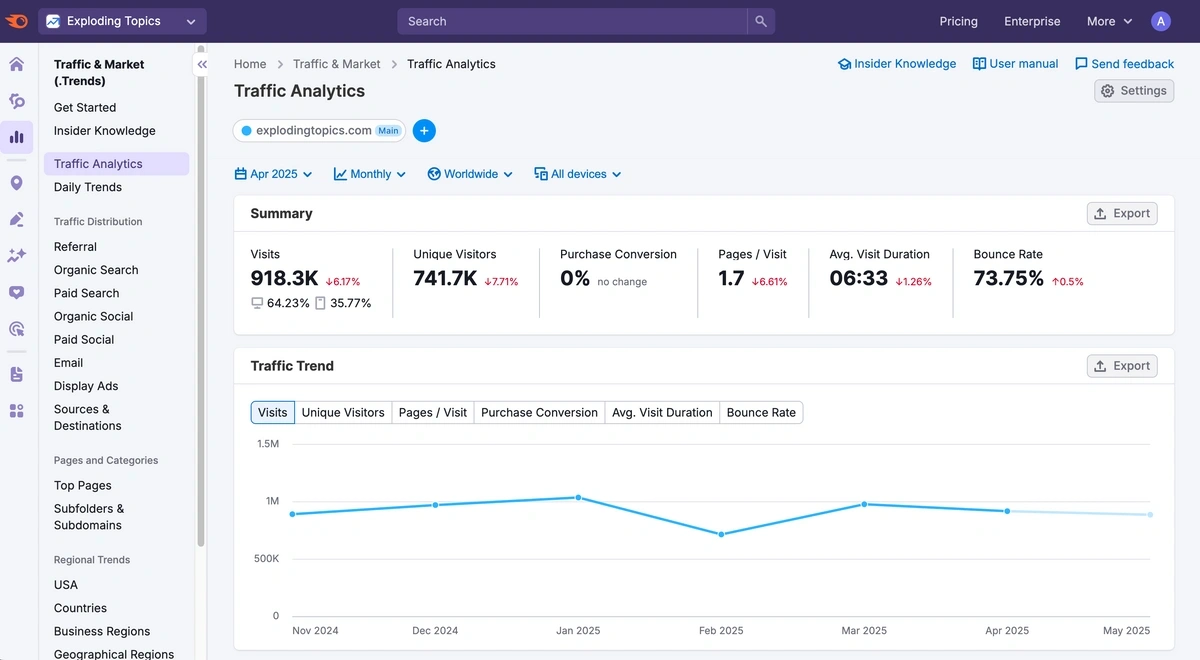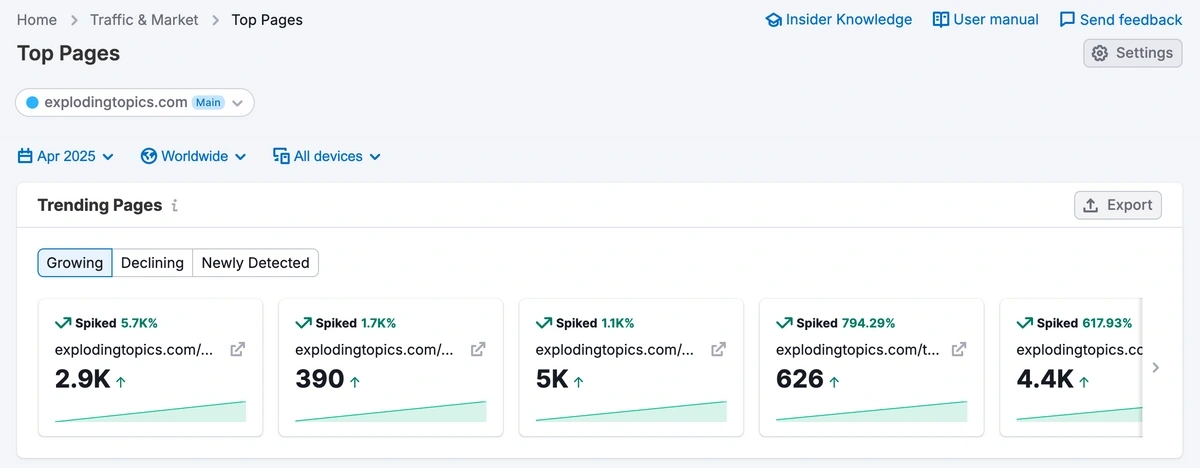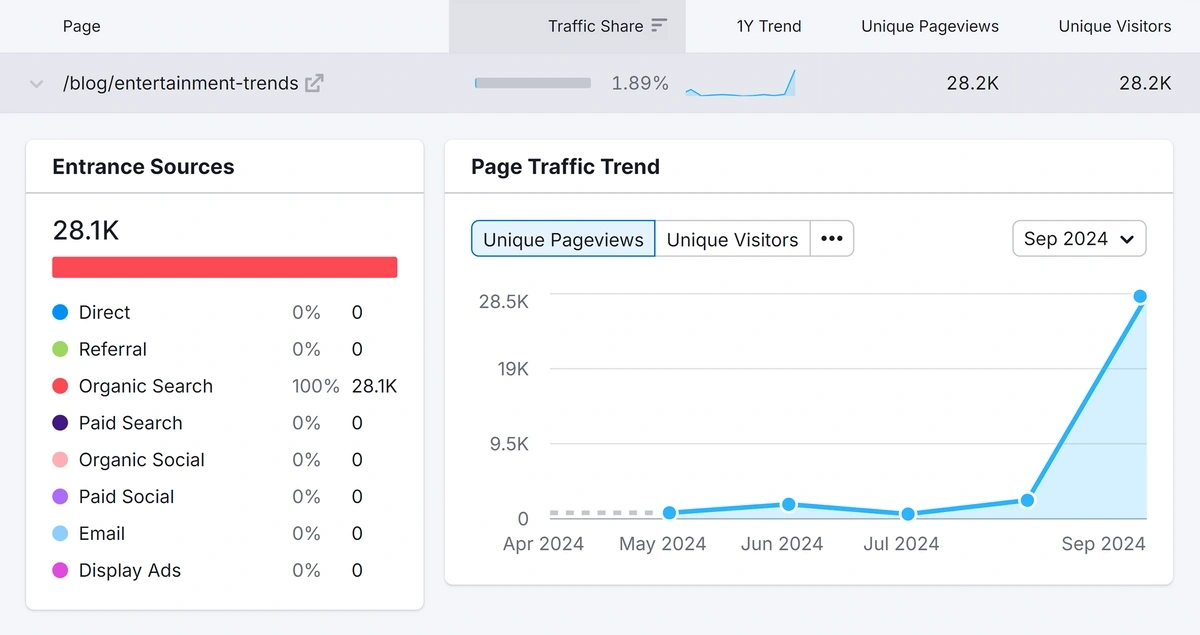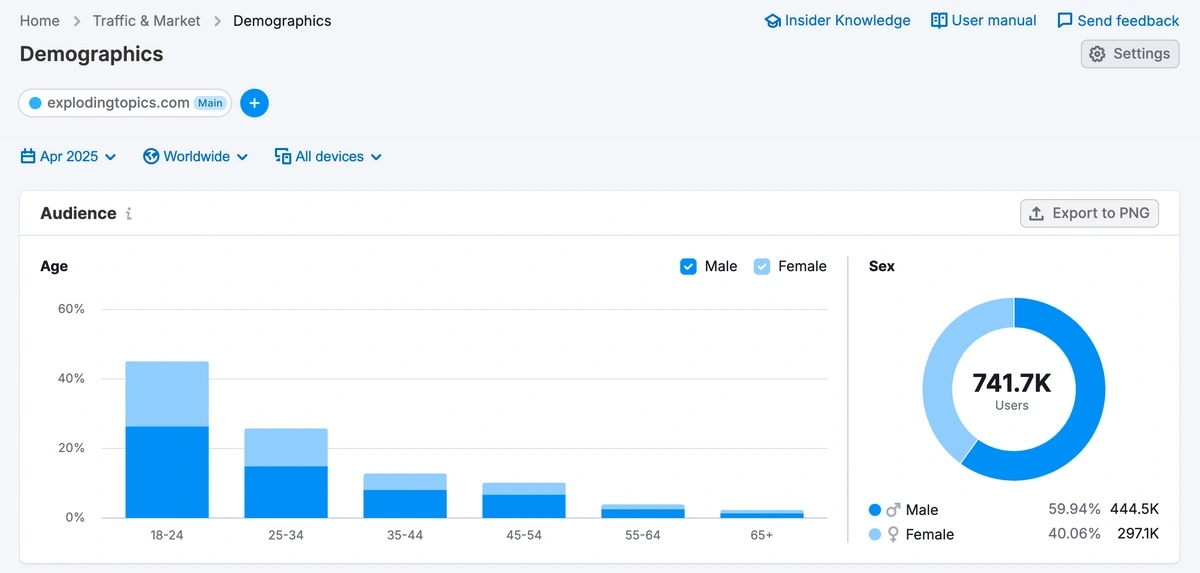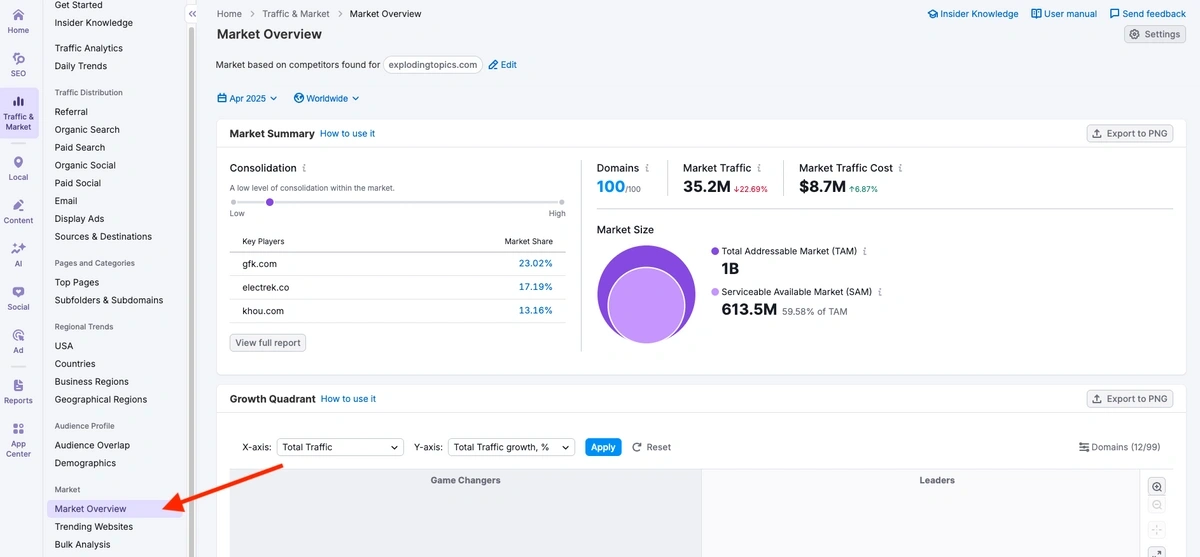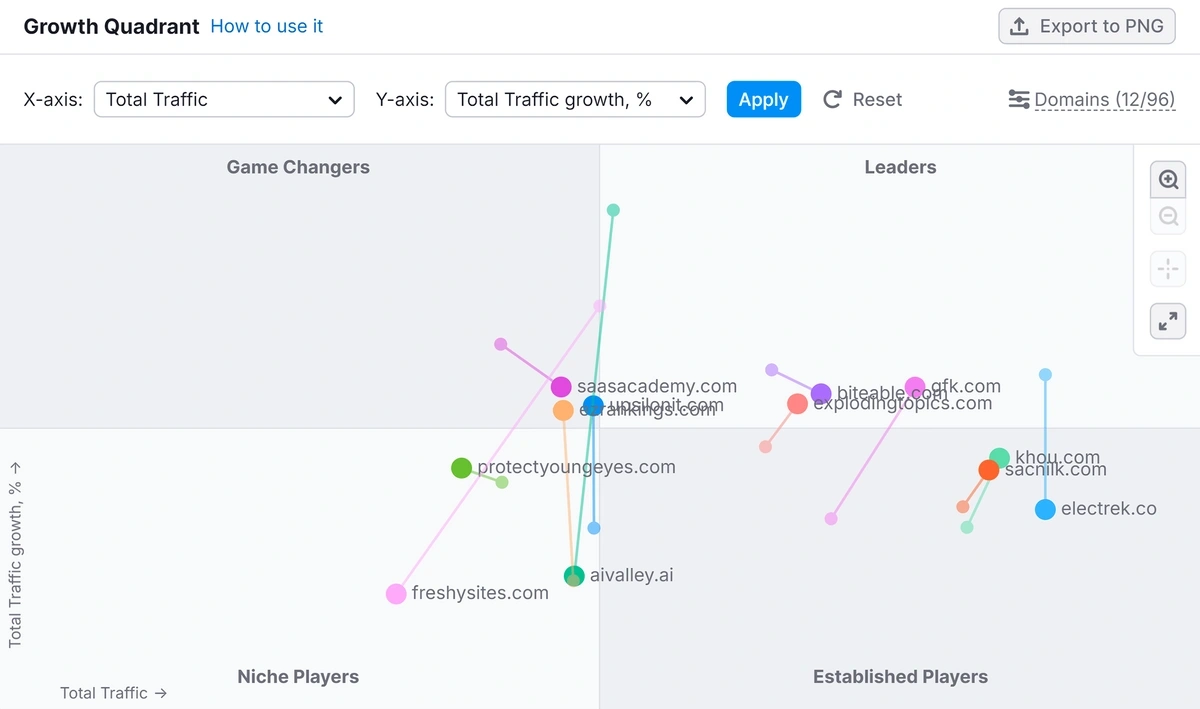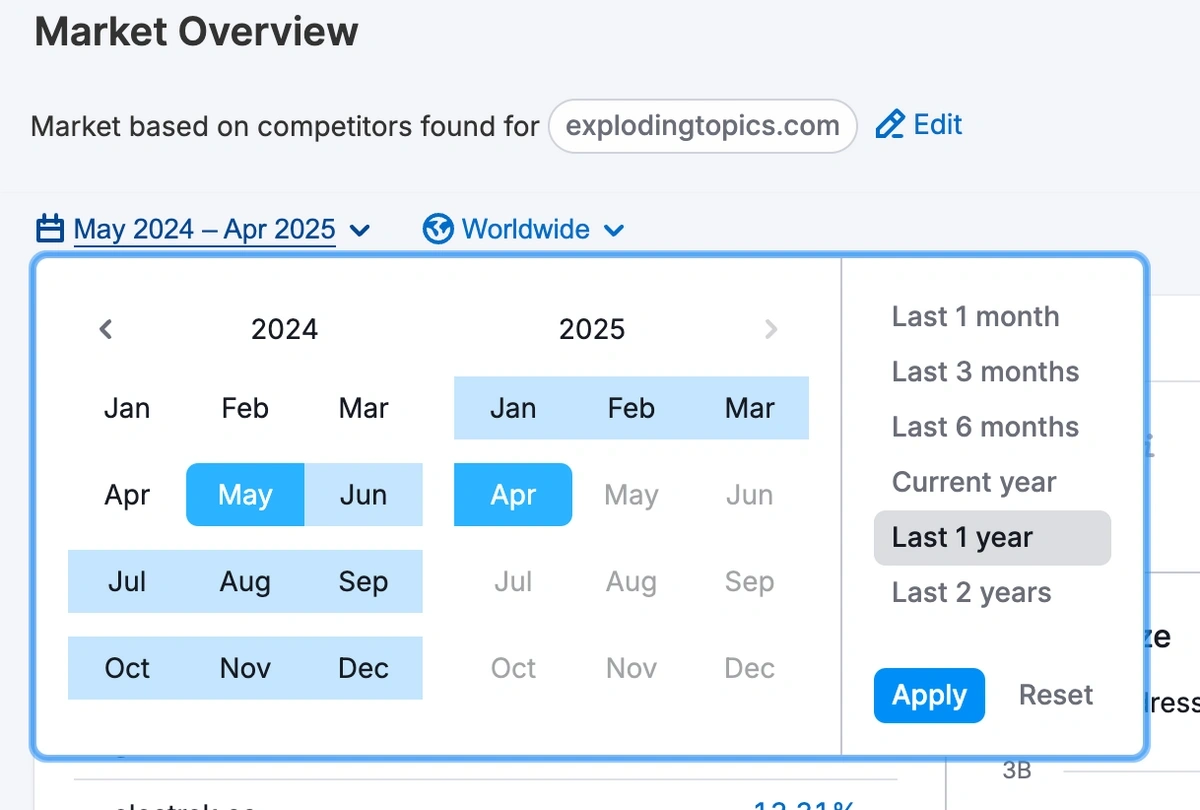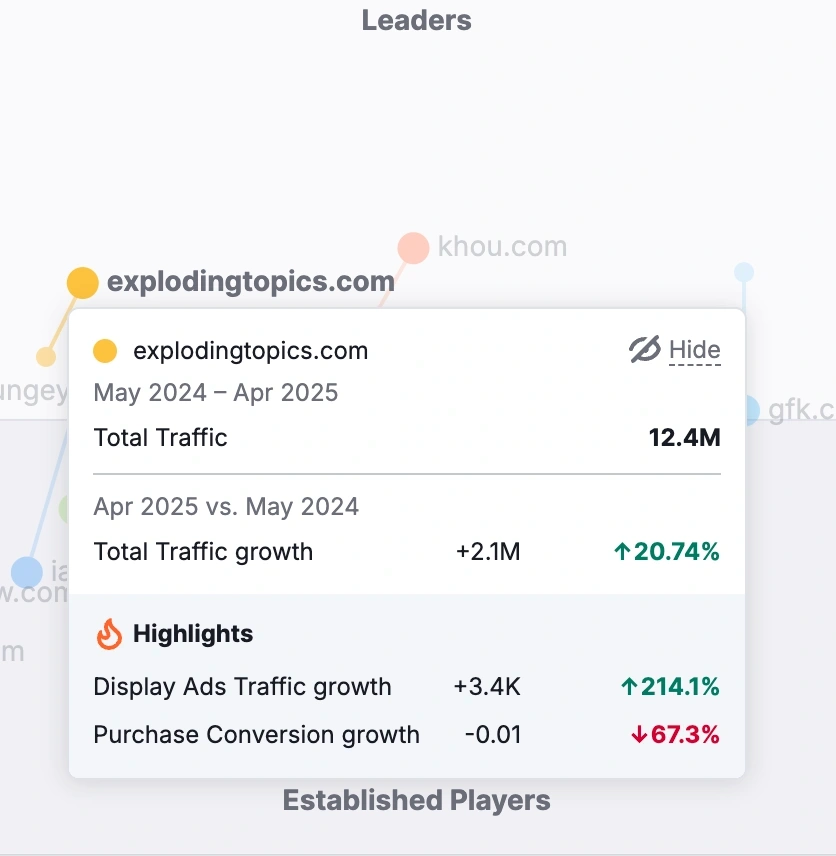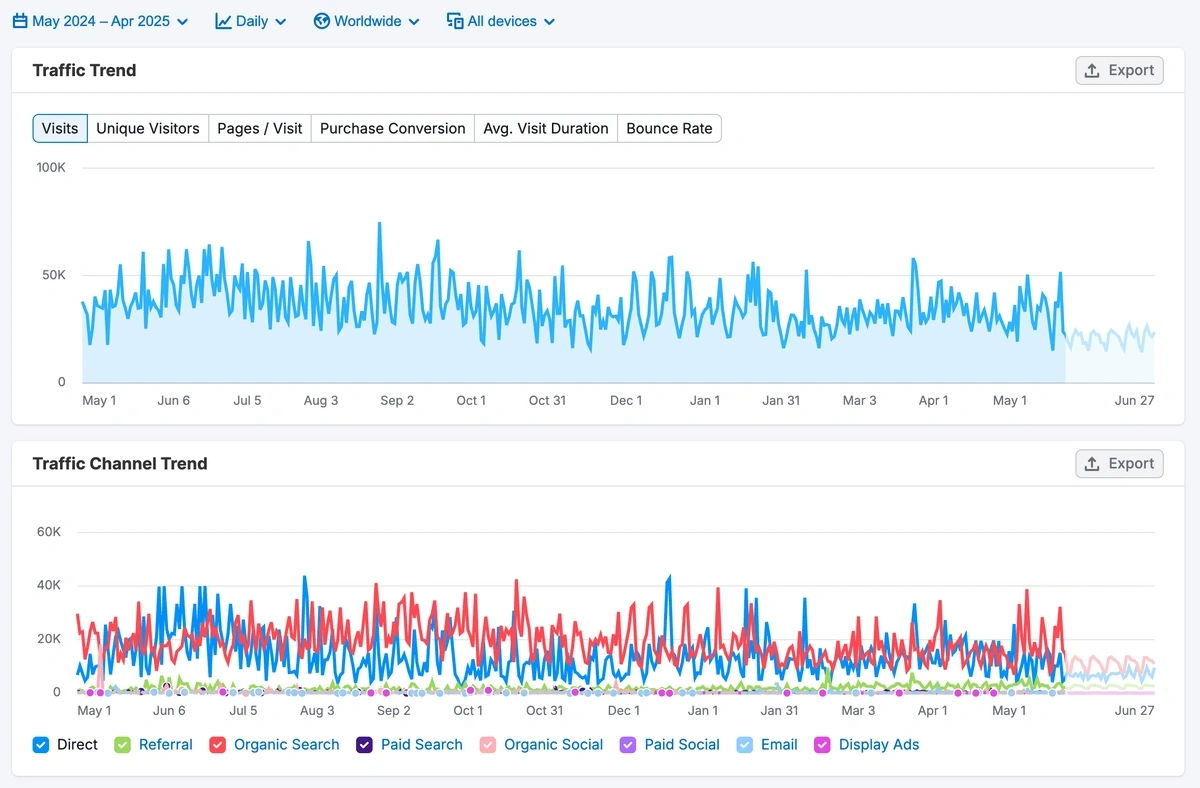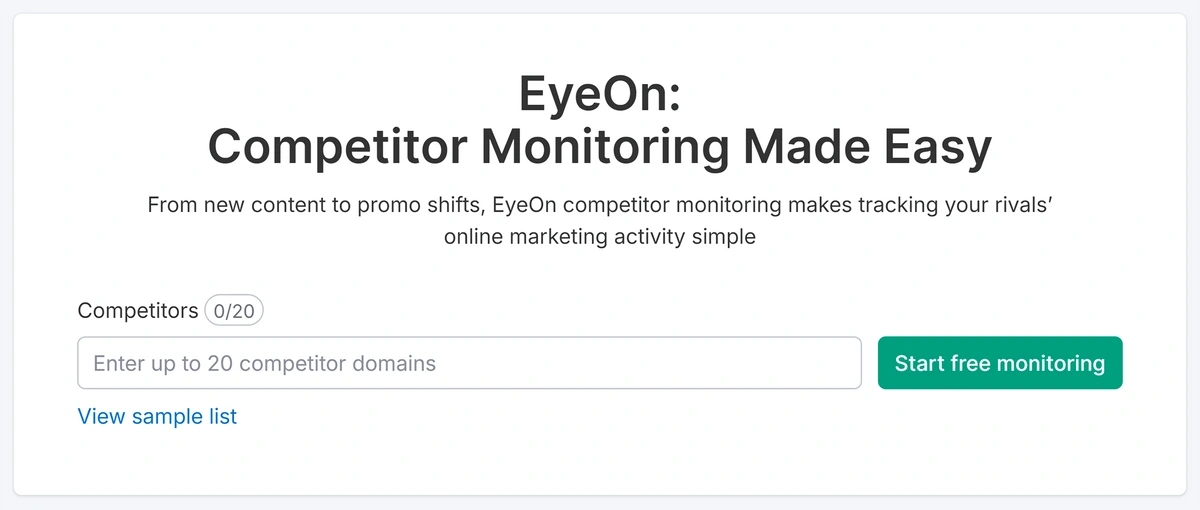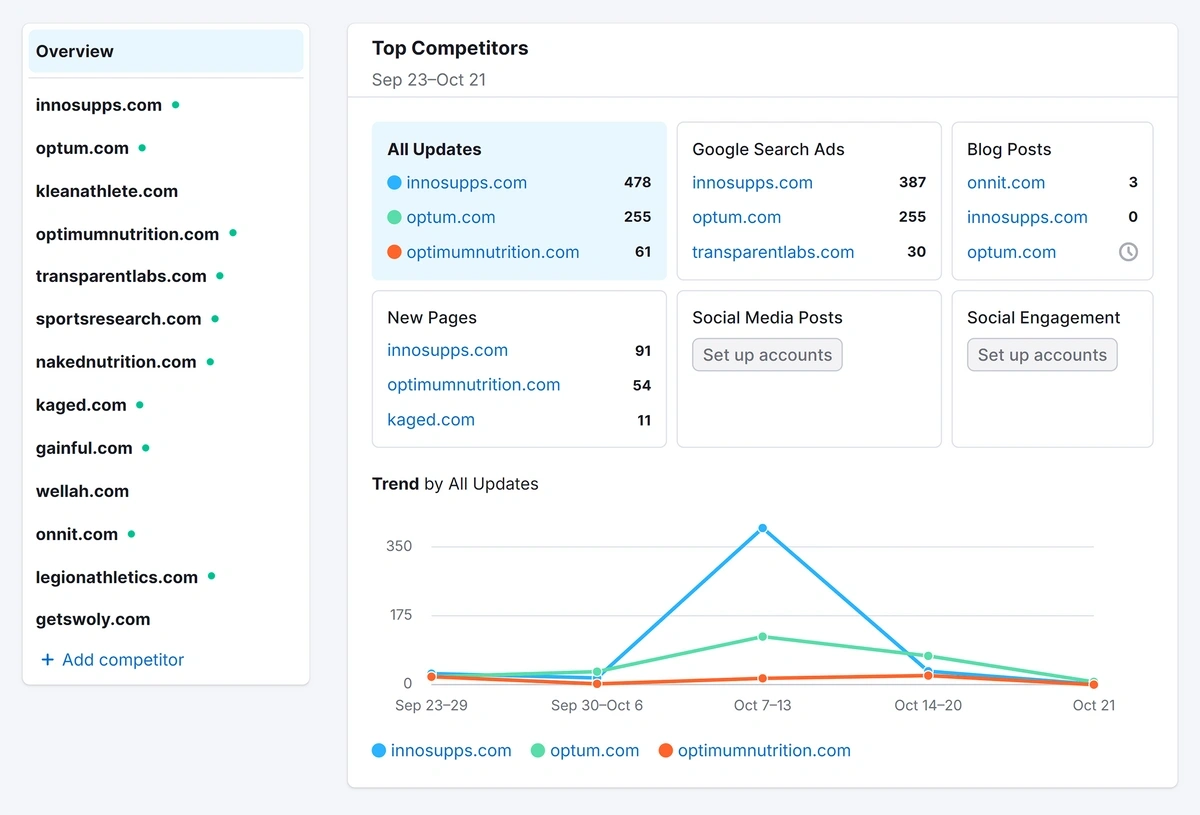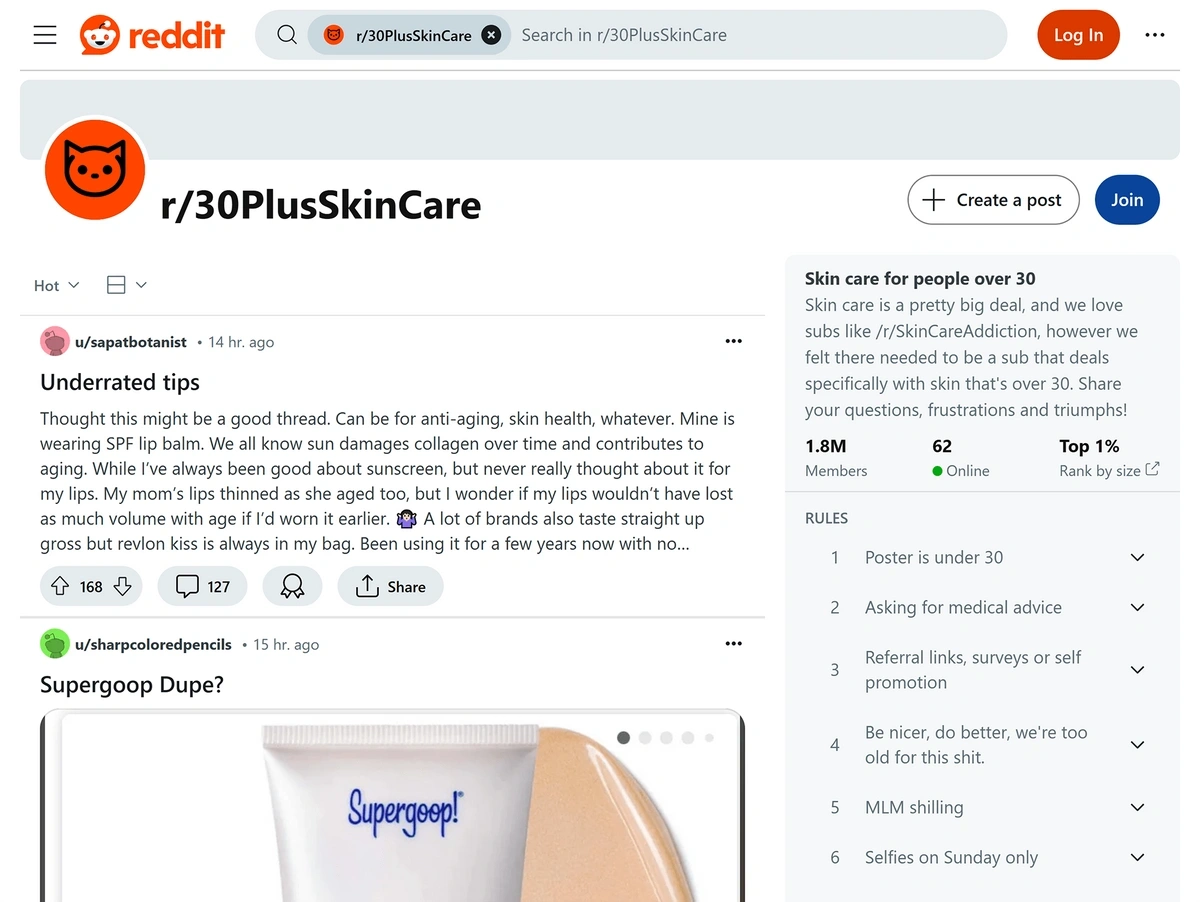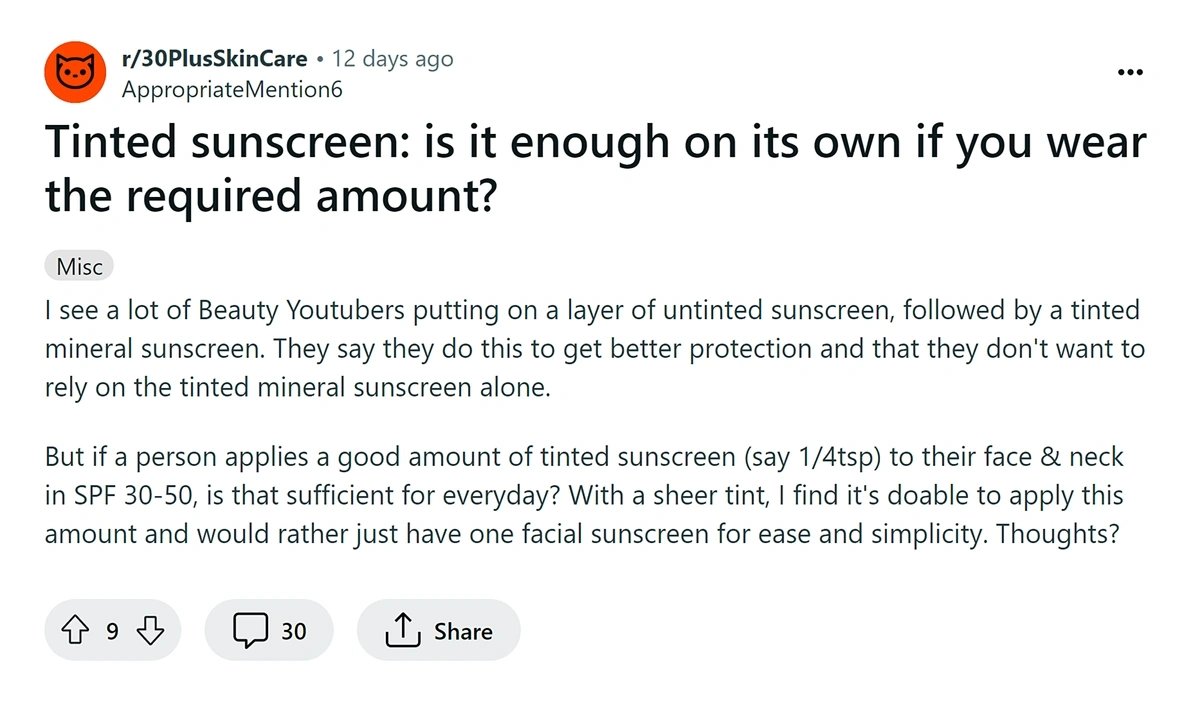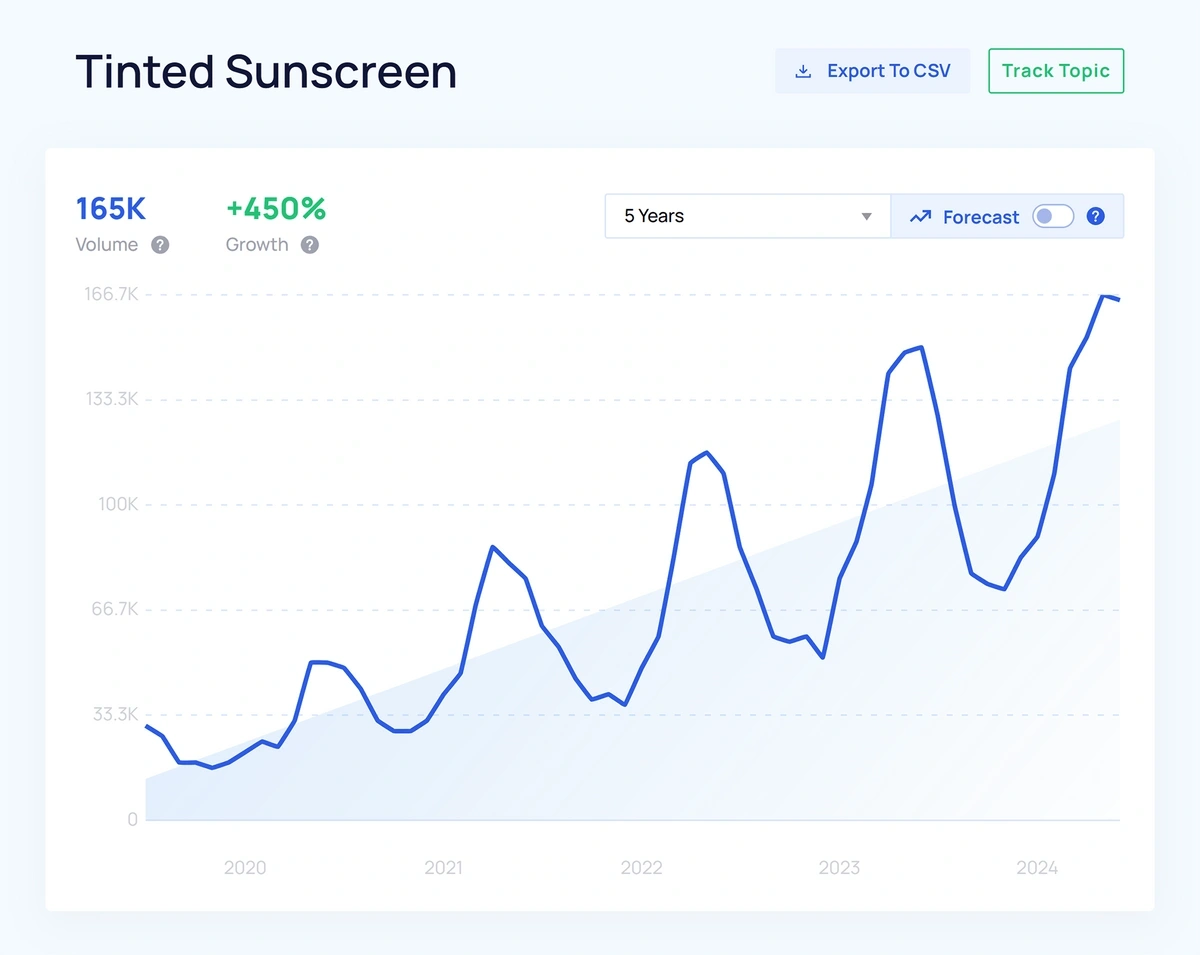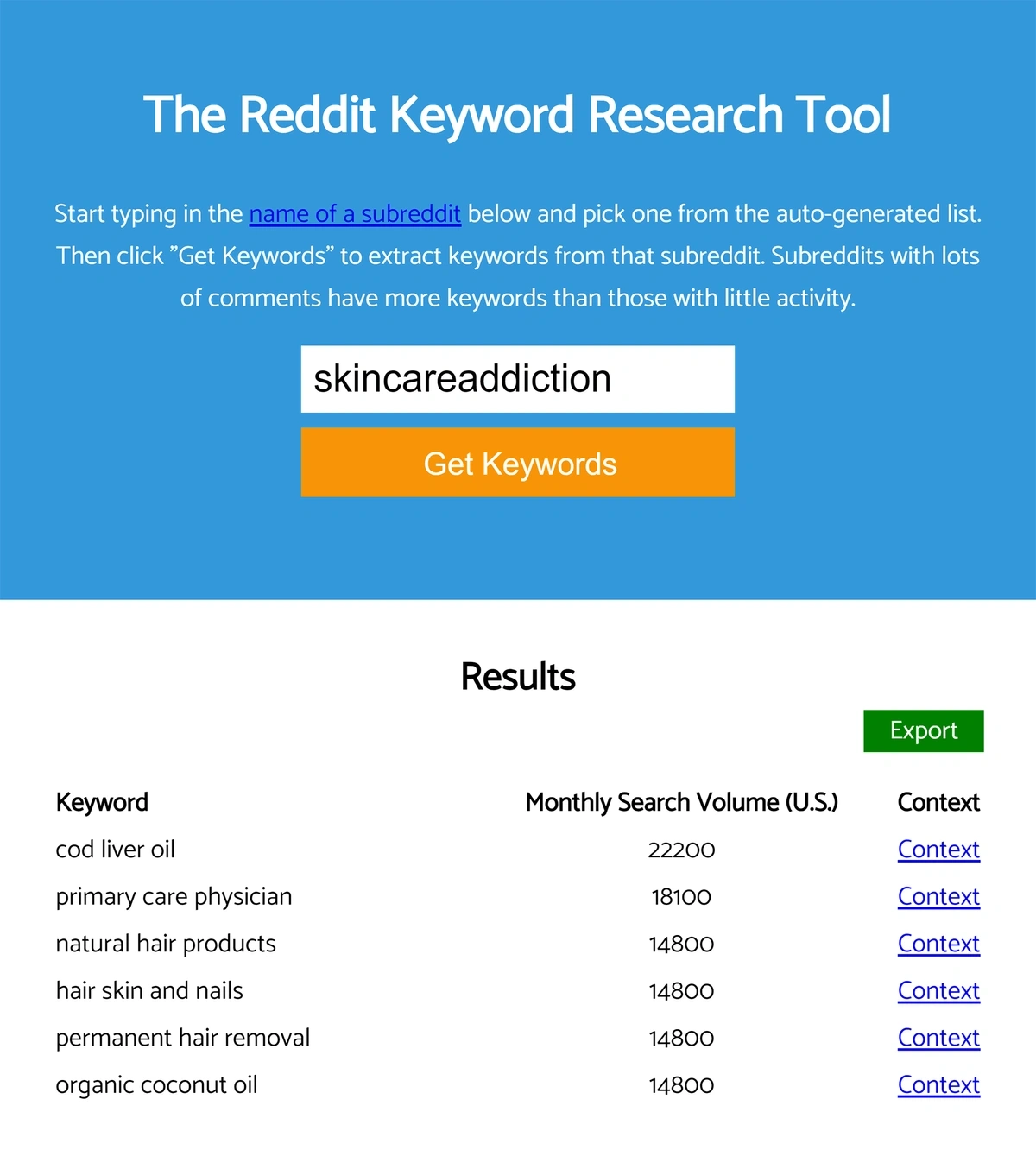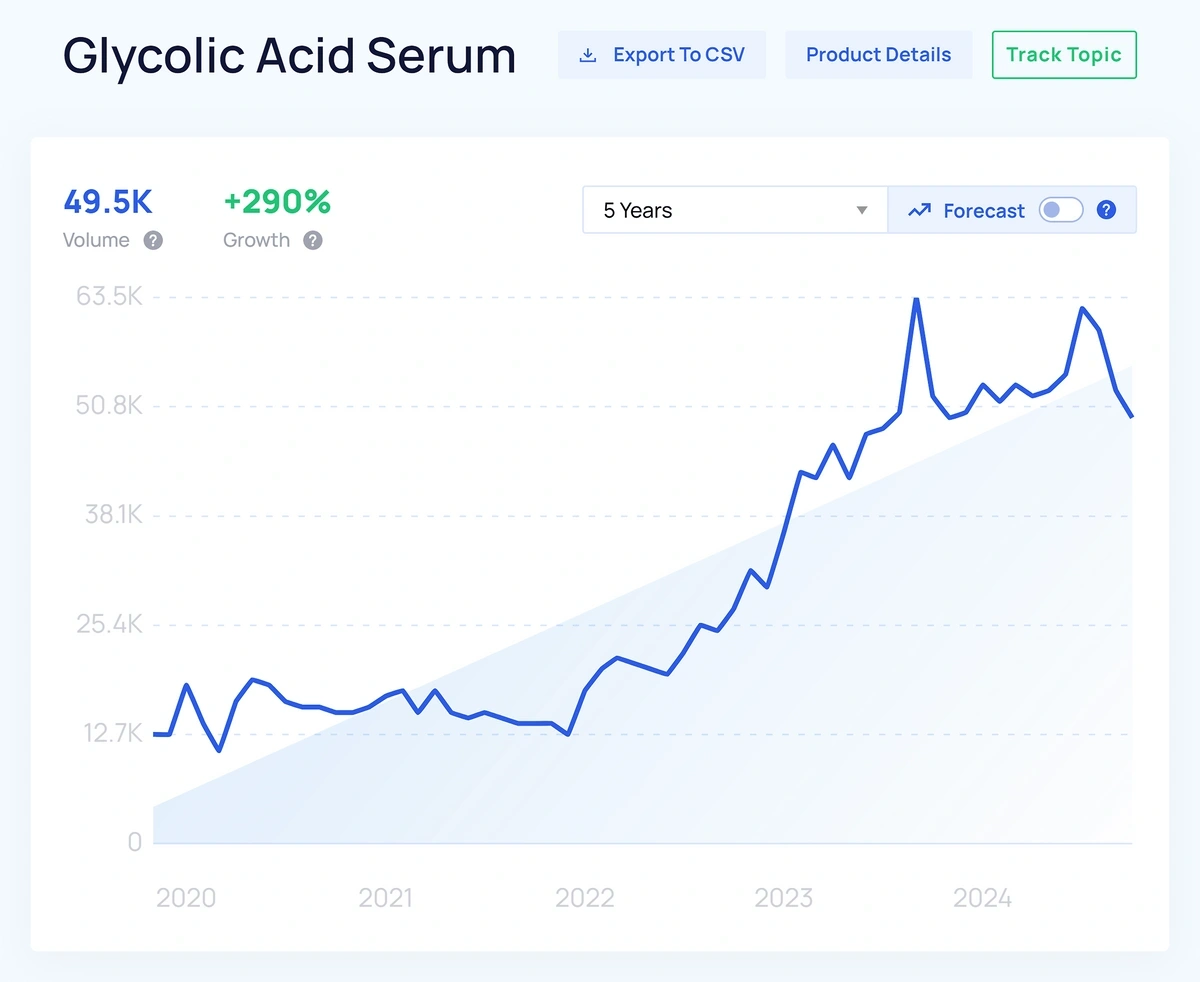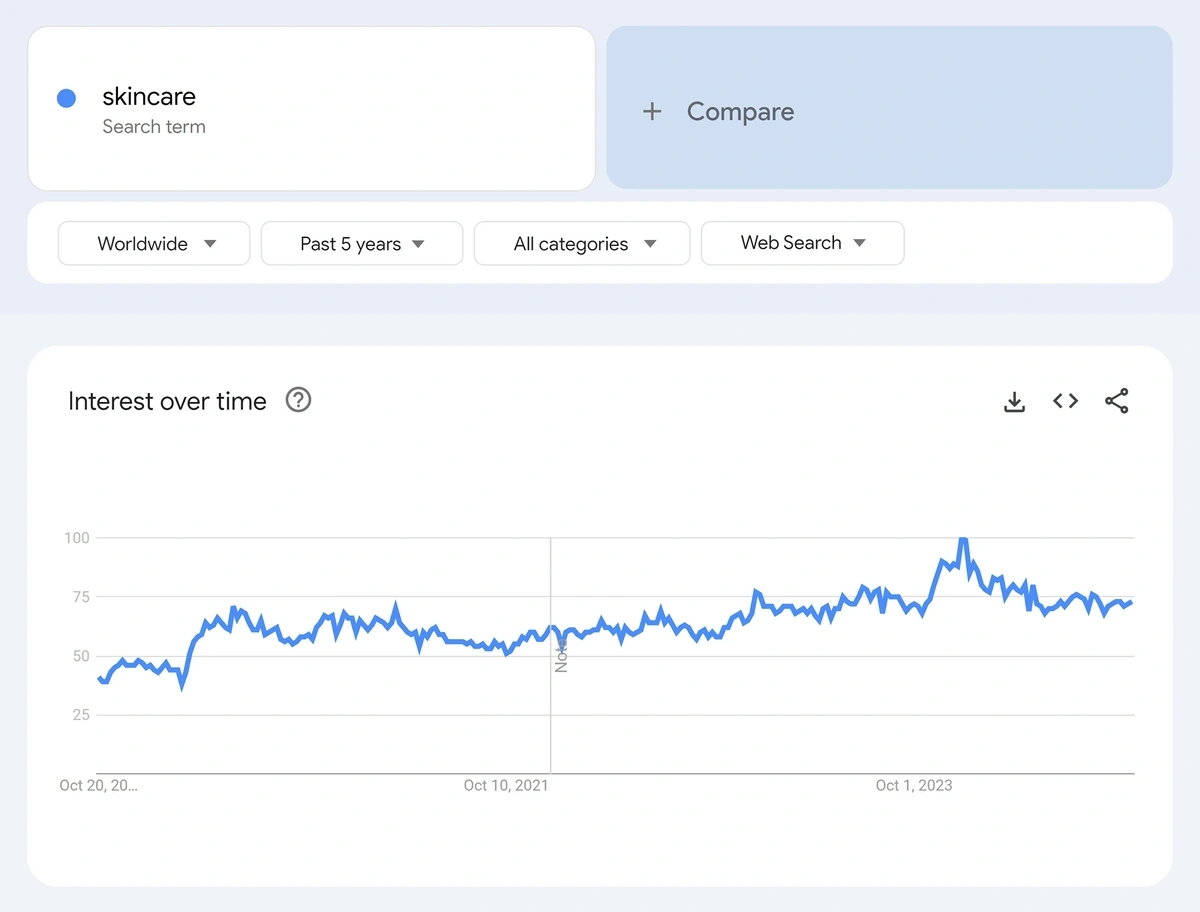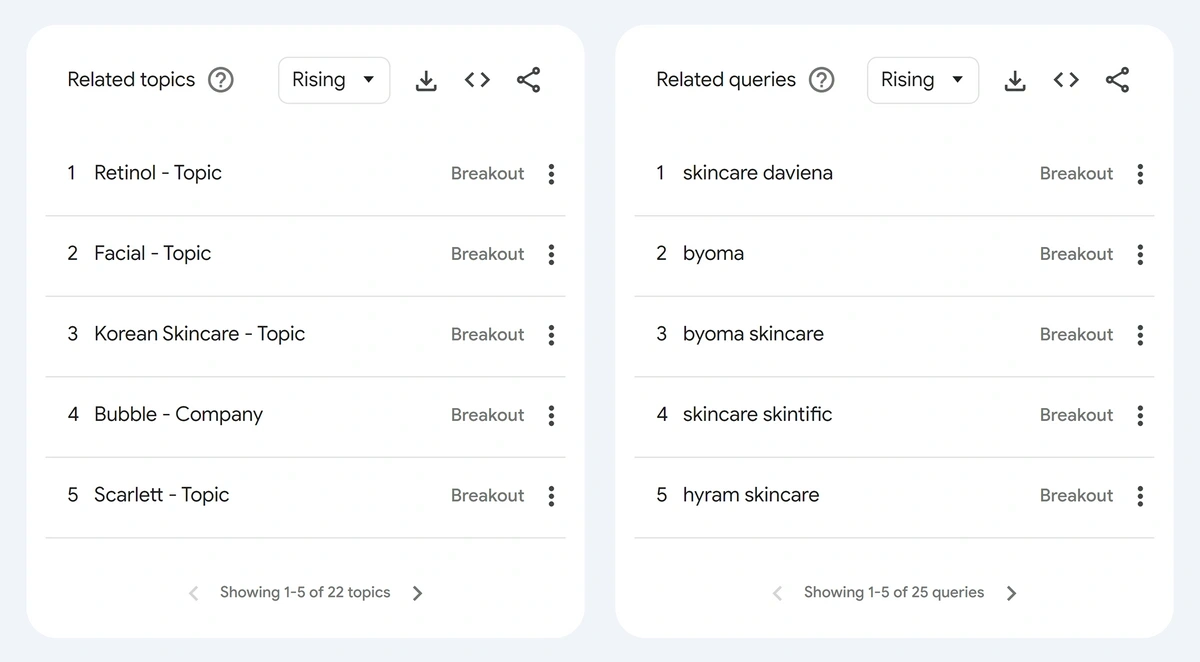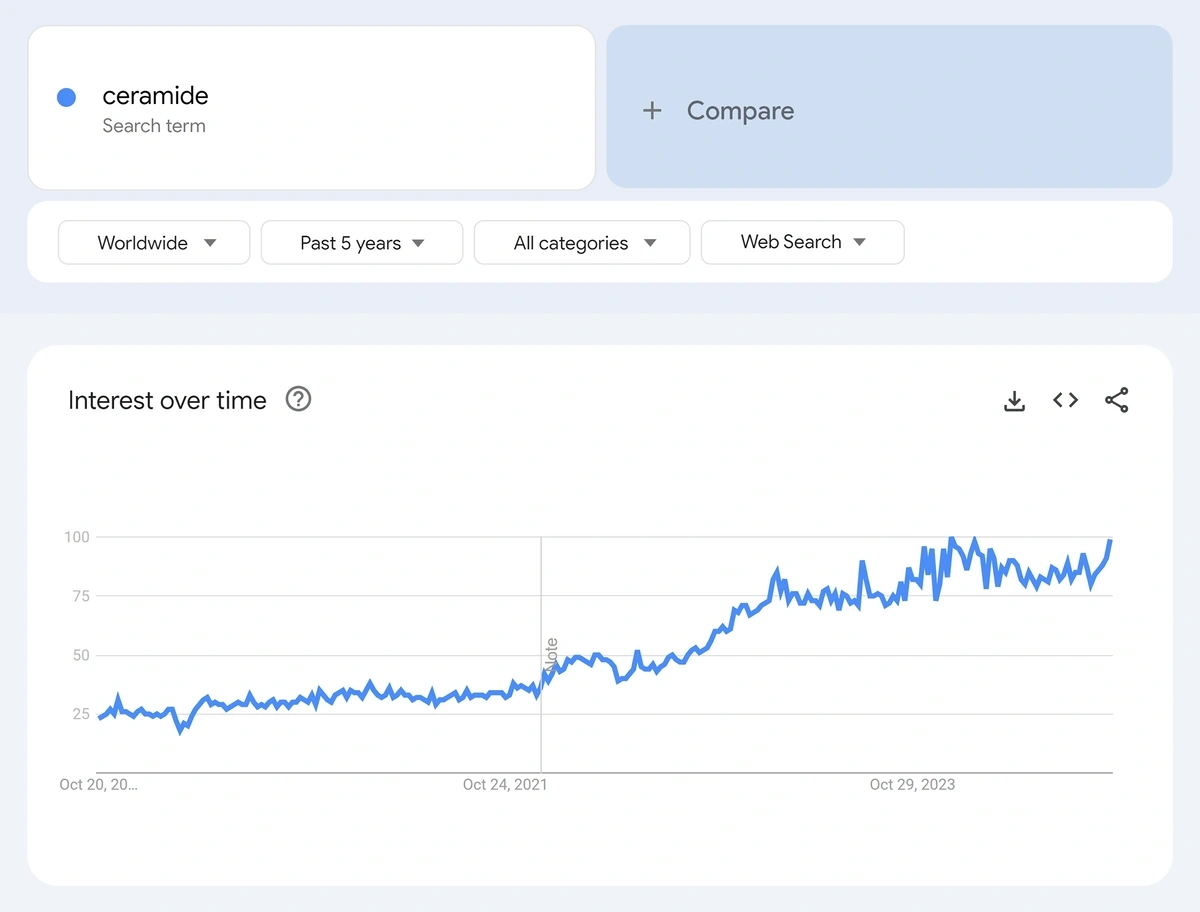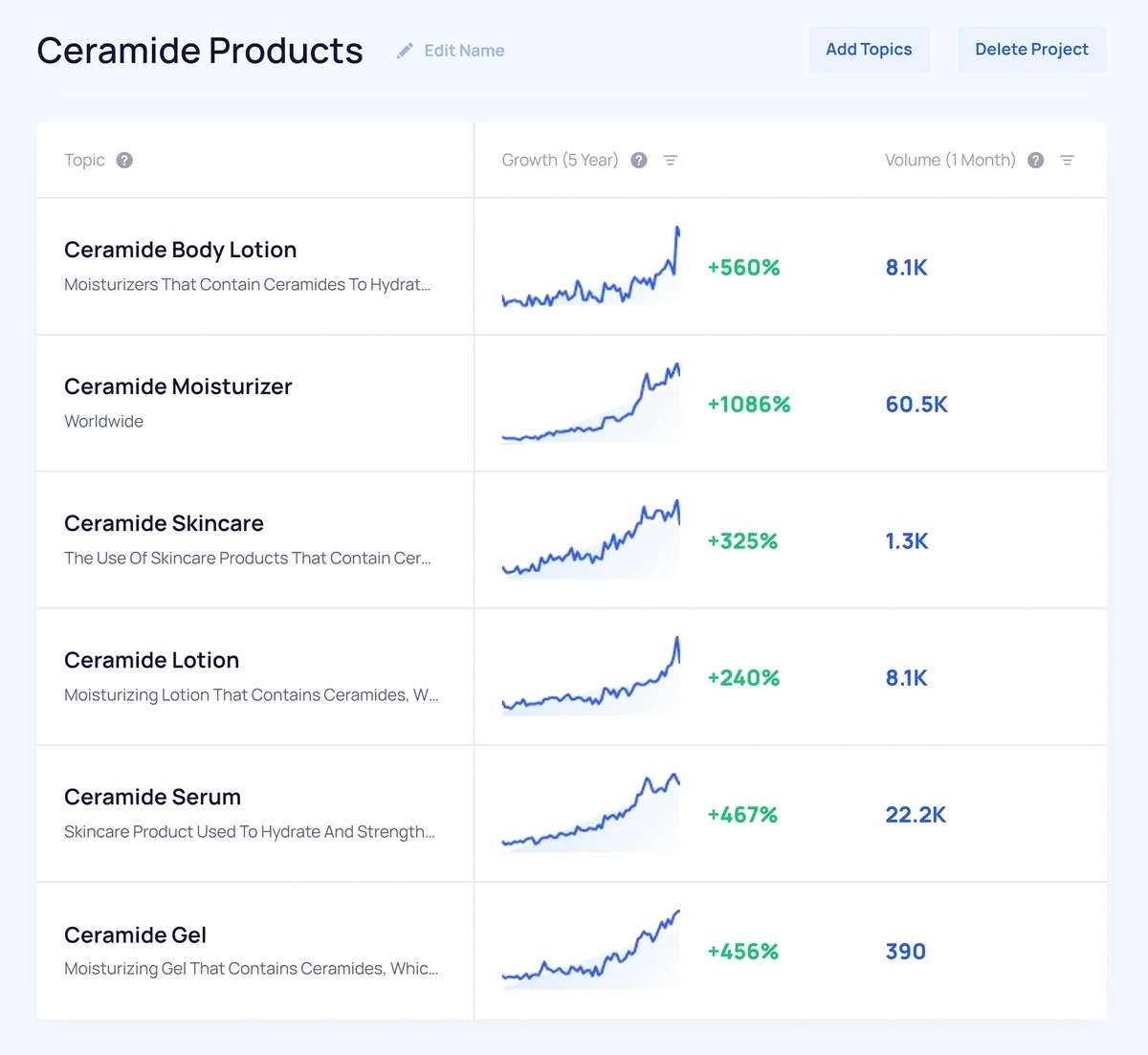
How to Spot Trends Before They Happen
This guide will walk you through the steps to find trending topics and analyze their viability and future potential.
Specifically, we're going to show you how to beat your competitors to the punch and spotting trends before they happen?
To do so, you'll need to utilize various trend-spotting websites, social media platforms, paid newsletters, and Google tools to find underserved or undiscovered topics.
1. Use Trend Spotting Tools To Find Trending Topics
It's possible to do trendspotting with 100% manual research.
However, since there is so much information to sift through and various steps required to validate a potential trend, using a trend-spotting tool makes things much more efficient.
For example, Exploding Topics spots emerging trends by tracking millions of data points with a proprietary trend-spotting algorithm.
You find rapidly growing trends here before anybody else.
There are also filters to drill down into exactly which types of trends you need to find:
- Industry trends
- Growth status
- Discovery date
- Search volume
- Brand
- Product
With the Exploding Topics Trends Database, you can scour through hundreds of thousands of already-tracked trends.
“AI writing” is an example of a trend we spotted well before it became mainstream. Today, if you were to mention AI writing, everybody in the room would likely know what you’re talking about (thanks largely to ChatGPT). But it wasn't always that way.
In fact, Exploding Topics Pro users were alerted about the potential of AI writing all the way back in July 2021, well before it became a common topic in the tech world.
If you were one of the members to identify this trend early on, you could have explored other relevant trends in our database to gauge demand.
By typing “AI Writing” into the Trends Database search bar, you can fetch other similar topics:
Other topics like “AI writing tool,” “AI content detector,” and “Sudowrite” all indicate there’s a clear demand for AI writing and plenty of successful startups fulfilling that demand.
Our algorithm gathers a trend’s search volume and calculates growth using our proprietary algorithm.
Then, we grade each trend and assign it a status so you can gauge where it's at in its lifecycle:
- Regular trends are trends with strong (but not exceptional) growth.
- Exploding trends are trends seeing an above-average amount of growth.
- Peaked trends are businesses, products, etc., that are already very well-known. Therefore, their growth has already hit an all-time high sometime in the past.
With this in mind, you can start searching for new trends in the Trends Database. First, select a category from the list. Each category includes hundreds of trending topics for a sub-category.
Let’s assume you work in the health & wellness niche. Choose a relevant sub-category, like sleep, and you’ll gain access to a list of trending topics.
You can get more targeted results by adjusting the search filters. For example, set the Status filter to "Exploding" and the Sort By filter to “Discovered Date.” This will adjust your view and show you the newest “Exploding” sleep topics that we are tracking.
Using these search parameters will generate plenty of potential sleep topics worth exploring, which has become an emerging wellness trend. One example that stood out was “Mouth Tape.”
Searches for "Mouth Tape" have taken off, which makes this a trend worth monitoring. Even major media outlets are covering "Mouth Tape” with features in CNN and National Geographic.
Now that we’ve found a trend with Exploding Topics, we can dig deeper to gauge its viability and determine whether it's worth pursuing.
2. Pay Attention To Social Media Sites
Social media is one of the best places to look for trend ideas.
That's because you can observe a niche group of people talking about a specific topic before major media outlets or competitors get word about it.
And with the rise of short-form content, trends starting on social media are becoming more common.
Hashtags are how you can stay in touch with trends on all the top social platforms like Instagram, X, Facebook, and TikTok.
But in many cases, you’ll need to find the trending hashtags yourself. This is where our discovered trends using Exploding Topics come in handy.
If you head over to TikTok, you’ll notice that there are plenty of hashtags and searches related to "Mouth Tape" and quite a few posts about the topic with millions of views.
Because of its popularity and the data it shares with users, TikTok is the best social platform for analyzing trends and finding new topic ideas.
As you can see, there are currently 18,100 posts on the platform with the "mouth tape” hashtag, which has generated over 100 million views.
You can also use the TikTok Creative Center, a business tool for finding trending hashtags and detailed analytics. However, it won’t include insights for every keyword or hashtag.
For example, no data is currently available for “#mouthtape,” but we can analyze another topic to see how the tool works.
Similar to Google Trends and Exploding Topics, you can see how this specific hashtag performs over time and whether the trend is rising or falling.
On TikTok, reaching 100 means the topic is approaching peak popularity.
Such a rapid climb in interest over time could indicate great demand for products or services related to this trend. However, it could also mean that you’re getting involved too late, and there’s already a sizable amount of competitors battling for search rankings or sales.
Other social listening tools like SparkToro and BuzzSumo can also be used to spot trends on social media platforms.
With SparkToro, you can learn all about a broad niche to find out what the audience is talking about online, the social accounts they follow, the websites they visit, the podcasts they listen to, and the YouTube channels they subscribe to.
Basically, Sparktoro shows what platforms your target audience is consuming media on. On the contrary, BuzzSumo gives you an idea of what media they're consuming.
3. Track Website Activity with Semrush
Analyzing website activity and organic search behavior is an under-the-radar trend detection method.
But it’s important to find reliable data. Otherwise, you can waste valuable time and resources with untrustworthy figures while building a marketing campaign.
The Semrush Traffic & Market Toolkit gives you direct access to advanced market research and competitive analysis features to uncover new trends.
Traffic Analytics
First, users can find interesting insights through the Traffic Analytics tool. It offers extensive website traffic data, competitor insights, engagement metrics, and emerging trends.
The tool uncovers a website’s most visited pages and ranks them by total Unique Pageviews. However, the most useful data for spotting new trends can be found in the Trending Pages section.
Here, you’ll see growing, declining, and newly detected pages. To find relevant data, go to the "Organic Search" tab on the left side menu under "Traffic Distribution." This filter only trending pages according to their organic search traffic.
Now, we have a view of the fastest-growing pages.
For example, our Top 8 Top Entertainment Trends post has experienced a 3,091.49% increase in traffic from August 2024 to September 2024.
Repeat this process until you’ve compiled a list of high-performing pages and topics from competitor websites. Use these topics to benchmark what is currently working and evaluate a potential market strategy or niche opportunity you could explore.
The Traffic & Market Toolkit also includes the Audience Profile feature. Rather than solely relying on already published content, consider analyzing audience demographics to uncover the latest trends and ideas.
From here, you can view a website's audience demographic, socioeconomic, and behavior data. This can help when creating new content to know who you are targeting and how to better relate to their interests.
Beyond trend research, this feature can also provide incredible market intelligence insights for market researchers, BD and sales teams, and marketers.
Market Overview
Market Overview from Semrush is another tool that can take your trend research to the next level. This feature helps users benchmark their business to competitors and get a deeper understanding of their niche.
Not only can you do advanced competitor research, but you can also see where you stand in the market by viewing the Growth Quadrant.
The matrix is divided into four quadrants: Leaders, Established Players, Game Changers, and Niche Players.
- Niche Players: They've yet to build a large audience, and traffic is relatively low or stagnant. These are beginner sites or sites that have yet to establish their online presence. This category is low traffic and low growth rates.
- Game Changers: Traffic is still low here, but they have higher-than-average growth rates compared to the market. This includes sites that could become new Leaders in their market. Think of these sites as low traffic and high growth rates.
- Leaders: Businesses and websites with massive audiences and high growth rates are Leaders. This can also include some of the most well-known companies that are newly expanding into a new region or market. Anybody in this category displays high traffic volume and a high growth rate.
- Established Players: Established sites have big audiences, but traffic is steady. You won't see many surges on a monthly basis, as these sites display high traffic volume and a low growth rate.
This can be your best friend while trend spotting.
Build a winning strategy
Get a complete view of your competitors to anticipate trends and lead your market
First, change the timeline at the top of the report to show the last year of data.
Now, you can analyze each site’s growth path to see how individual domains have grown over the past year. For example, our growth over the past 12 months has catapulted us into the Leaders quadrant of our space.
Analyze everybody’s path to see what caused their spikes or drops in traffic. Note strategies that worked and how these sites implemented strategies to succeed within the broader market. There could be hidden consumer trends that other players in the market are missing.
Finally, you should look at the Daily Trends dashboard to track day-by-day changes across your major traffic channels.
Look at the peaks and valleys in your market's total traffic graph. Compare that to how individual sites performed. For those that saw increases while the market declined, check what they did differently.
While this overview is useful, it's also important to see how you stack up against specific competitors. We suggest using additional tools for a more detailed competitive analysis.
EyeOn
Semrush's EyeOn is another way trend hunters can stay ahead of the market. The tool primarily allows you to monitor your competitors' activities with regular updates about newly published content.
For example, you can get notified anytime a competitor:
- Publishes a new blog post
- Launches a new online advertising campaign
- Creates a new page on their website
- Posts something new on social media (Facebook, Instagram, and X)
Once you create a list of competitors you want to monitor, Semrush will send you weekly digests with all new updates about your competitor's activities. Gathering this data manually would require hours of work.
Instead, you can use EyeOn, which leverages Semrush's full suite of tools. For example, all new blog posts are detected from RSS feeds of your tracked domains. Similarly, EyeOn detects new website pages by monitoring domain sitemaps.
For new online ads or social media posts, EyeOn integrates with Semrush's Advertising Research tool and the Semrush Social Media toolkit to gather Google Search Ad data and social media updates.
If you are just starting out, here’s how to set up EyeOn to provide useful updates to spot relevant trends before they happen.
First, let’s assume you work in the supplements niche. Make a list of up to 20 competitors (between 10-20 is best), input them into the EyeOn search bar, and click “Start free monitoring.”
After submitting your list, Semrush will generate a new report.
The report includes an overview of all competitor domains and the top competitors by category (total updates, Google Ads, new blog posts, new pages, etc.).
Connect your company’s social accounts to unlock social engagement and social media post tracking. You can also adjust the calendar to view historical update results.
For example, analyzing results in November and December could uncover some interesting insights because brands in this niche experience spikes in traffic and sales during the holiday shopping months.
EyeOn offers a new way to spot trends early by tracking and analyzing competitor activity. With this data at your fingertips, you can never fall behind in the market.
Studying competitor blog titles, Google Ads campaigns, new social media posts, and recently published website pages can help you uncover:
- Upcoming product launches
- New product promotions
- Changes in audience targeting or product positioning
- Proven marketing and sales tactics
Ready to stay ahead of your competitors and spot new trends before anybody else? Sign up for a free Semrush account now.
4. Use Subreddits To Your Advantage
Digging through subreddits can be a goldmine for finding undiscovered trends.
The best thing about Reddit is that these conversations happen in real-time, similar to other social media platforms like Twitter and TikTok. To get started, begin with a broad search like “Skincare” to find the dedicated subreddit for this topic.
Right away, r/30PlusSkinCare and r/SkincareAddiction were some of the first to appear. On the surface, r/30PlusSkinCare seems like it would be a small, niche community.
But there are 1.4 million members and nearly a dozen new posts per day. You can dive deeper into subreddits like this to find potential trends.
Here’s one example: a post about tinted sunscreen.
Now I can head over to my trend-spotting tool, Exploding Topics, to see if this topic is worth looking into further.
Clearly, this is an upward trending topic with seasonal dips during winter months. Trends like this show potential for skincare brands looking to start a new product line or skincare blogs looking for new SEO keywords.
You can automate this process using the HigherVisibility Reddit keyword research tool. Start by typing the subreddit name into a search bar, and the tool pulls the most popular keywords.
Next, export your keyword list and start looking for potential undiscovered trends. Typically, this would be more likely for keywords with lower search volume further down the list.
Another trend I found using this method was “Glycolic Acid Serum.” The term has displayed clear growth over the past 12-24 months, indicating a growing trend that has massive potential.
Using Reddit to find trends is certainly not foolproof, as it requires manual labor and patience to find topics. But it’s one effective way to find undiscovered or underserved long-term trends.
5. Join Paid Newsletters For Curated Information
Experts are building email lists and sending out all types of newsletters to cover niche industries, from AI to CPG.
You can subscribe to several free and paid newsletters in technology and business to get curated trend data delivered straight to your inbox.
The Exploding Topics newsletter is one worth considering.
Each week, the Exploding Topics newsletter covers four rapidly trending topics with key insights and analysis.
Reading this weekly report can spark some inspiration during your trend research process and point you in the right direction.
You can use these curated email newsletters to reduce the manual workload required during trend research. Experts are behind the scenes compiling data and adding unique insights that you can access for free.
5. Use Google’s Tools To Validate Trends
Google Trends analyzes Google web searches during a time period and shows the topic’s popularity over time. On the graph, 100 is the highest point, indicating peak interest in a specific topic.
To get started with trend research, a broad topic or keyword like “Skincare” is a good place to start.
As you can see, interest in skincare remained steady until a spike in early 2024. But as we know, the skincare industry is not a new trend and this spike can likely be attributed to holiday shopping.
To dig deeper, Google Trends gives us “related queries," which is where we can spot new trends that are gaining steam.
Based on our original search, here are the “related topics” and “related queries" for skincare over the past 12 months.
Breakout topics and queries are the most notable because that indicates the term has grown by more than 5,000%.
Many of these topics and queries are existing brands in the industry. But right away, I spotted a trend in related topics and related queries.
Anua Skincare is a Korean skincare brand that sells products in this niche. That would lead me to research different Korean skincare trends and underserved products.
One example I spotted in the list of related queries was ceramide products, including ceramide cream, lotion, moisturizer, and toner. The use of ceramides for skincare originated in Korea and has become a staple in Korean skincare.
Interest in ceramide has only risen over the last five years. Stable trend growth with minimal spikes like this shows a viable long-term trend.
To confirm this trend, I would head over to Exploding Topics to check the status of and track various ceramide topics. As suspected, plenty of ceramide skincare products show upward exploding growth, indicating a potential trend opportunity.
You can monitor these trends in Exploding Topics to see their growth over time.
Next, Build Your Marketing Strategy
Now, it’s time for you to start implementing this approach and discovering new trends.
Combining the advanced AI algorithm from a trend-spotting site like Exploding Topics with a detailed research tool is the best way to uncover new topics before they go mainstream.
Semrush provides the advanced data you need to find emerging trends before they take off.
Sign up for a free Semrush account to spot the next wave of trends before they happen!
Stop Guessing, Start Growing 🚀
Use real-time topic data to create content that resonates and brings results.
Exploding Topics is owned by Semrush. Our mission is to provide accurate data and expert insights on emerging trends. Unless otherwise noted, this page’s content was written by either an employee or a paid contractor of Semrush Inc.
Share
Newsletter Signup
By clicking “Subscribe” you agree to Semrush Privacy Policy and consent to Semrush using your contact data for newsletter purposes
Written By


Anthony is a Content Writer at Exploding Topics. Before joining the team, Anthony spent over four years managing content strat... Read more

